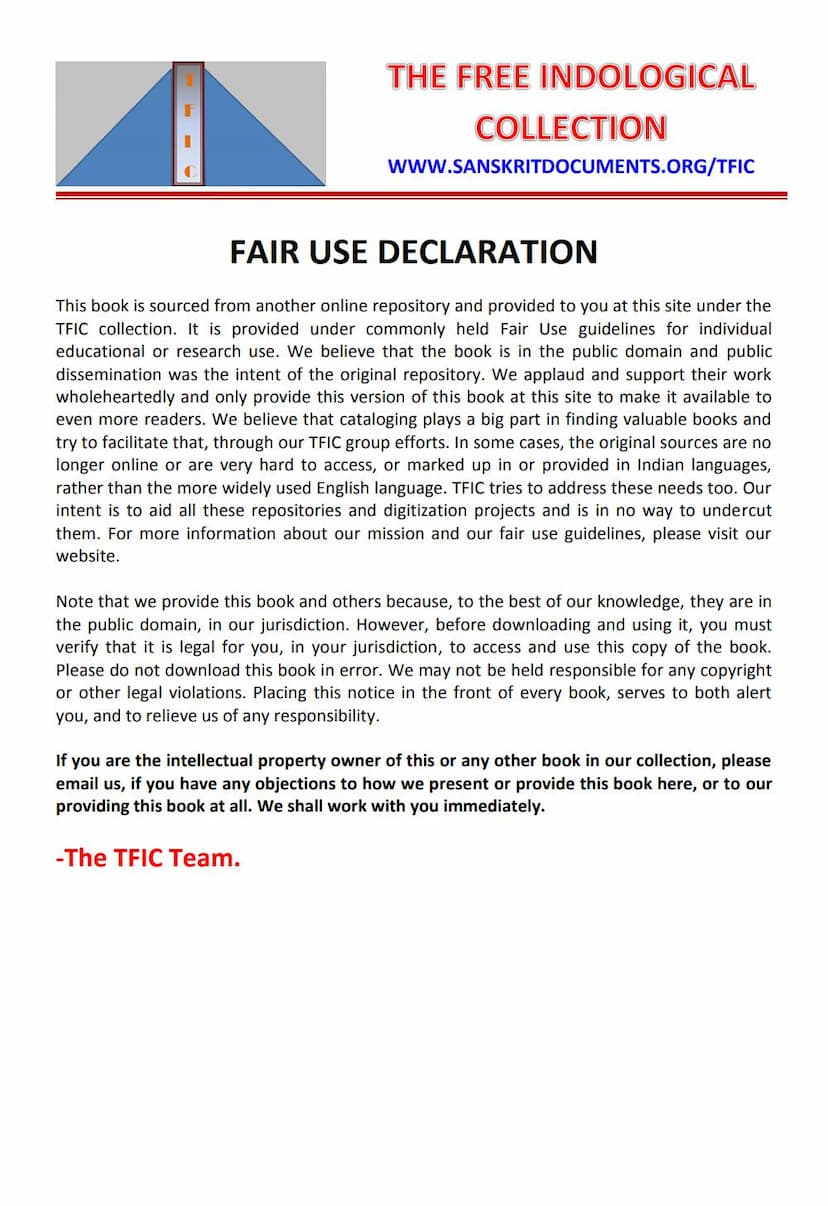Jainagamo Me Syadvada
Added to library: September 2, 2025

Summary
Here's a comprehensive summary of the Jain text "जैनागमों में स्याद्-वाद" (Jaināgamoṁ meṁ Syād-vāda) by Atmaramji Maharaj, based on the provided text:
Book Title: जैनागमों में स्याद्-वाद (Jaināgamoṁ meṁ Syād-vāda) Author: Atmaramji Maharaj Publisher: Jain Shastramala Karyalaya Ludhiyana
Overall Purpose: This book is a compilation and detailed explanation of the doctrine of Syadvada (also known as Anekantavada) as found within the Jain Agamas (sacred scriptures). The primary aim is to present the multifaceted nature of truth and reality as taught by Jainism, emphasizing the importance of multiple perspectives and the limitations of one-sided or absolute viewpoints.
Key Concepts and Themes:
-
Definition of Syadvada:
- Syadvada is composed of two words: "Syat" (स्यात्) and "Vada" (वाद).
- "Syat" is an indeclinable word that signifies "in some way" or "from a particular perspective." It indicates that a statement is not absolute but conditional.
- "Vada" means "statement" or "assertion."
- Therefore, Syadvada is the assertion of truth from a particular perspective, acknowledging that reality possesses multiple facets.
-
Syadvada and Anekantavada:
- The text explicitly states that Syadvada is another name for Anekantavada (the doctrine of manifoldness).
- Anekantavada is the absence of Ekantavada (one-sided or absolute assertion).
- Ekantavada views a subject from only one perspective, while Anekantavada considers it from various viewpoints.
-
Critique of Ekantavada (One-Sided Assertion):
- Ekantavada is described as incomplete, a distortion of truth, and a hinderance to societal harmony and individual peace.
- An analogy is given of a person described differently by their son (father), daughter-in-law (uncle), mother (son), and brother (cousin). If each person insists their view is the absolute truth, conflict arises. Ekantavada fuels such conflicts.
- The text argues that Ekantavada leads to disputes because it ignores other valid perspectives.
-
The Solution Offered by Anekantavada (Syadvada):
- Anekantavada resolves these disputes by acknowledging the validity of each perspective. It explains that the person is indeed a father from the son's viewpoint, an uncle from the daughter-in-law's, a son from the mother's, and a brother from the brother's.
- The core principle is that a single entity can possess multiple, seemingly contradictory qualities when viewed from different standpoints.
-
Philosophical Examples of Syadvada:
- The Three-Inch Line: A line that is three inches long is relatively larger than a two-inch line but relatively smaller than a five-inch line. Syadvada would say, "Perhaps it is short" or "Perhaps it is long," acknowledging both relative qualities.
- Nitya (Eternal) and Anitya (Transient): Jain philosophy, through Syadvada, reconciles the apparent contradiction of something being both eternal and transient.
- Example of a Gold Bangle: The gold itself is eternal (Nitya), as it remains gold regardless of its form. However, the bangle's form as a "bangle" is transient (Anitya) because it can be melted down and reshaped into other ornaments.
- Syadvada explains this by stating, "Perhaps the soul is eternal (from the perspective of its substance) and perhaps it is transient (from the perspective of its modifications/states)." The embodied soul changes states (like from human to animal), making its current state transient, but its underlying essence (soul-substance) remains eternal.
-
Historical Context and Divine Intervention:
- The text vividly describes a historical period (during Lord Mahavira's time) where intellectual and philosophical disputes, fueled by Ekantavada, led to violence and societal unrest. Pandits would physically fight over their one-sided doctrines.
- Lord Mahavira is presented as a physician who diagnosed the root cause of this societal illness as Ekantavada and prescribed the "divine medicine" of Anekantavada.
- He urged people to abandon their rigid adherence to singular viewpoints and embrace the understanding of multiple perspectives, fostering love and brotherhood.
-
The Role of Syadvada in Universal Harmony:
- Syadvada is presented as a powerful tool for reconciliation, understanding, and peace.
- It fosters a spirit of tolerance and non-aggression towards other philosophies.
- If all philosophers abandoned their rigid dogmatism and adopted the Anekantavada approach, all philosophical questions could be easily resolved.
-
Syadvada in Jain Scriptures:
- The book highlights that Syadvada is intricately woven into the fabric of the Jain Agamas.
- Examples from the Bhagvati Sutra are provided, where Lord Mahavira uses Syadvada to answer questions, such as whether the soul is eternal or transient, responding with "Perhaps it is eternal, perhaps it is transient."
- The book also mentions the inclusion of specific scriptural sections from Prajnapana Sutra and Sutrakritanga to illustrate Syadvada.
-
Compilation and Author's Contribution:
- The book is the result of a long-held desire by scholars and followers to compile all relevant scriptural passages on Syadvada, along with ancient Sanskrit commentaries, into one accessible volume.
- Atmaramji Maharaj, described as a profound scholar and devoted practitioner of the Agamas, is credited with fulfilling this need through his extensive study and diligent compilation.
-
Appreciation and Call to Action:
- The book expresses gratitude to contributors and encourages readers to benefit from this collection, which saves them the effort of searching through numerous texts.
- The author's diligent work is emphasized, hoping it contributes to the propagation of Jain philosophy.
In essence, "Jaināgamoṁ meṁ Syād-vāda" is a foundational text for understanding a core philosophical principle of Jainism. It argues that truth is complex and cannot be captured by a single, absolute viewpoint. By embracing Syadvada/Anekantavada, individuals and society can move towards greater understanding, tolerance, peace, and a more complete apprehension of reality.